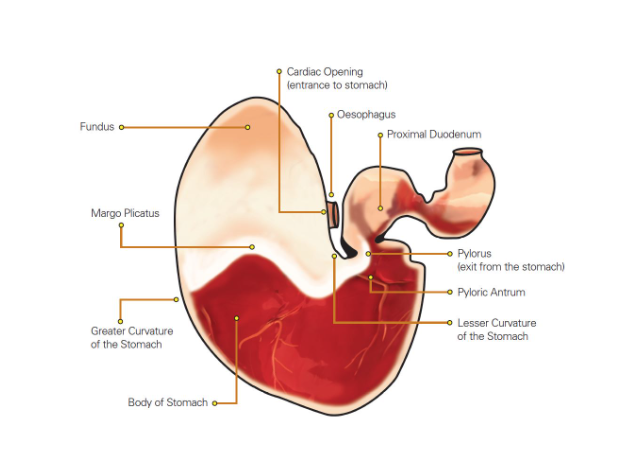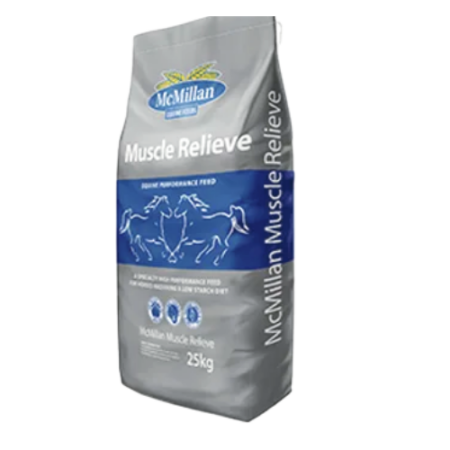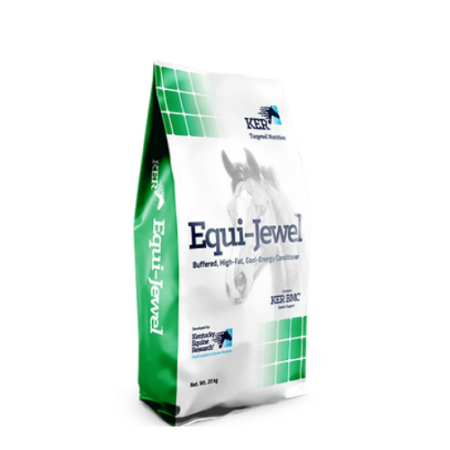Ulcers
Ulcers are small wounds to the stomach lining caused by stomach acid. They are one of the most common medical conditions seen in horses and ponies across all ages and disciplines.
Horses produce stomach acid continually, and are evolved to always be grazing. This ensures there is always saliva (and bicarbonate) coming into the stomach with the food to help neutralise acid. Additionally, because of the continual grazing, the stomach is emptied into the intestines often, so acid moves through into the rest of the digestive tract. The stomach can be divided into 2 regions. The large bottom region, the glandular stomach, is where the acid is made. This area protects itself against ulceration by secreting bicarbonate to buffer the acid, as well as a mucous layer. The top region, the squamous stomach, does not have these protective mechanisms but is protected from the acid by the presence of feed material in the stomach causing a fibre mat that stops the acid sloshing up and damaging the tissue.

Ulcers are categorised into two types:
Squamous: these are ulcers that affect the squamous part of the stomach (the top region in the image). Usually, this is secondary to acid sloshing about. Improving the fibre content of the horse, and ensuring that there is an adequate fibre mat in the stomach, particularly prior to exercise/travel is a crucial part of feeding horses that are prone to these kinds of ulcers.
Glandular: these are ulcers that occur in the bottom region of the stomach. These are caused usually due to disruptions in the blood flow to this region, and decreased mucous or bicarbonate production.
Causes and Clinical Signs:
What causes ulcers is multifactorial and complex. Individual horse temperament, stress levels (physical, environmental and social stress), underlying conditions or diseases, exercise (increased sloshing of the stomach contents), and diet have all been implicated.
Ulcers can cause a multitude of clinical signs. Some horses with severe lesions in their stomachs present with only mild signs of discomfort, and others with mild lesions suffer from regular low grade colic as a result. Ulcers can cause horses to be “girthy”, uncomfortable being brushed or tacked up, reluctant to move forwards under saddle, colicky, reluctant to eat or finish their feeds, poor performance etc. The range of clinical signs means that ulcers are often blamed for a horse’s poor performance or behaviour change, however these are not signs specific for ulcers. Therefore you should consult your veterinarian to obtain a diagnosis and create a treatment plan tailored to your horse.
Feeding the EGUS horse:
Diet is an extremely helpful additive to an ulcer treatment plan, and knowing how to feed these horses will help maintain a healthy stomach after treatment has been completed. However, these are broad recommendations to complement your veterinary treatment and advice and are not to be treated as a replacement for therapeutic medications if these are prescribed.
Firstly, adequate fibre is crucial to maintain a healthy gut, and increasing the fibre content of feeds is often recommended for horses with ulcers.Total forage intake for horses should equal 1.5-2% of their bodyweight, and should not drop below this. Chewing long fibre stems such as hay, promotes saliva and bicarbonate production which will help neutralise the stomach acid. Lucerne may also be helpful to help buffer the stomach acid, as it is calcium and protein rich.
Where possible, horses should be turned out in paddocks to allow for constant grazing and fibre access. This helps ensure there are no long periods of time that the horse has no fibre in its stomach, so the fibre mat is maintained. If paddock turn out is not possible, it is hugely important to allow horses access to adlib hay, and ensure they have access to fibre at all times. For horses who tend to guts their hay, or who are overweight, small hole hay nets or trickle nets are a good option as they slow hay consumption, meaning the horse eats less over a long period of time. This both maintains the fibre matt in the stomach and prevents over consumption. Similarly, providing horses with small amounts of fibre (such as lucerne, hay, chaff or a fibre dense feed) before exercise and travel has been found to be helpful in ulcer management and prevention as it ensures a healthy fibre mat is present, which reduces the risk of stomach acid splashing up into the squamous part of the stomach during exercise.

Further, studies have shown that when horses are removed from pasture and fed more than 2g/kg body weight of starch a day, the likelihood of developing EGUS increases significantly (Sykes et al., 2015). That is not to say grains can’t be fed, but it is recommended to keep these as low as possible (below 2g/kg body weight of starch a day). As many horses with/recovering from ulcers are reported to have lost weight or be low in energy, vegetable oils offer a good source of energy dense calories without the addition of grains/starch. Small feeds often are also better than one large feed a day as this helps maintain the fibre matt in the stomach.
Finally, there are a multitude of gastric supplements on the market, many of which have limited peer reviewed studies. However, provision of supplements that aim to buffer acid (e.g. magnesium oxide) and other products such as lecithin have been the subject of some studies that show it may have some use, but these do not replace veterinary medication.
Forme Equine products recommended for at risk horses and ponies:
Here are some links which include more comprehensive information around feeding and managing equines at risk of ulcers and hindgut acidosis:
Equine Gastric Ulcers – Using Feeding Management to Reduce Their Incidence and Severity
Symptoms of Gastric Ulcers in horses?
Prevention of Gastric Ulcers in horses
Why do Gastric Ulcers appear in horses?
What are Gastric Ulcers in horses?
Refill and re-buffer the horses stomach
Does My Horse Have Gastric Ulcers? Causes, Signs, Treatment & Prevention
Ulcer Treatment For Horses: Why And What To Do?
[Video] Diagnostic And Treatment Of Gastric Ulcers In Horses



